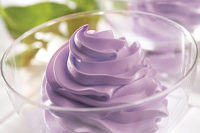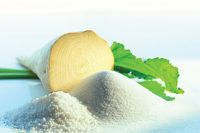The blue and the green
Diane Hnat, senior technical marketing manager at DSM, said that dairy manufacturers can capture everything from “nuanced as well as bolder versions of yellowish-orange, to reddish-orange, ‘eggy,’ ‘salmony,’ and ‘strawberry’ shades” using carotenoids. On the other hand, she said, a blue or green dairy product “conveys a nontraditional or nonconventional combination of dairy with ‘something else’ added.”
Put another way, blue or green dairy just doesn’t seem natural. As such, it’s probably no great hardship that the only consistently high-performing blue and green colorants for dairy have been synthetic. And we might safely assume, too, that the typical consumer of a blue-raspberry frozen novelty or “slime-green” squeezable yogurt wouldn’t blanch at seeing FD&C Blue #1 on an ingredient label. (Don’t believe me? Just ask your 12-year-old son.)
But dairy formulators who aim to go green (or blue) naturally have limited options. As Marlena Hidlay, marketing manager, coloration, at DSM, said, “Many European companies have made the switch to natural sources such as spirulina, beet juice, chlorophyll or bilberry extract to achieve these bright hues. Other companies are using water-soluble anthocyanins or flavonoids with pigments that may appear red, purple or blue according to the product pH.”
But these options offer imperfect stability in dairy applications, and some, like sodium copper chlorophyllin — which FDA permits as a colorant only in dried citrus beverage mixes — offer little benefit to dairy manufacturers. Thus, Hidlay said, “Blue and green remain a challenge.”
Color suppliers aren’t giving up, though. Ford said that Wild has developed a natural, acid-stable blue color derived from fruit juice that produces “vibrant, even pastel-like” blue tones in low- and high-pH dairy environments. It comes in liquid, dry and oil-soluble forms and is ideal for flavored milk and dairy-based beverages, yogurt, frozen desserts, dairy dips and spreads.
But in time, nailing that spot-on blue or green — whether naturally or otherwise — may not be so important. “Though the progression may be slow,” Ford said, “the coloring of dairy products as a whole is leaning more towards realism.”
And, really, when was the last time you saw a blue raspberry anyway?
LycoRed’s Bedrack credits the buying public’s shift in perspective.
“Consumers’ awareness and preference for having natural colorings in their dairy foods is very important,” she said. “And because more products are popping up on shelves with natural colorants, the consumer is getting used to the fact that ‘natural’ doesn’t mean ‘bright and shiny,’ but maybe a little more cloudy and pale. It’s not always eye-catching, but it’s becoming mainstream.”
And it’s a sign that a bright future awaits colorful dairy products.






